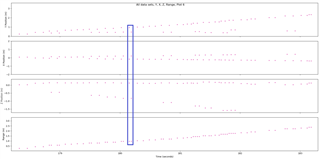Hi There,
I’m using an IWR6843ISK to measure the falling velocity of a small object along the y-axis (directly away from the antennas).
The radar seems to be returning the data in pairs, and the spatial coordinates of the second sample in each pair seems wrong. The reconstructed range looks correct however, even for the erroneous second sample.
Below is a plot showing the X, Y, Z and Range values against Time, with one such pair highlighted.

Why do you think this is happening?
I've also attached the cfg if that's relevant.5_2_2_2_profile_2023_02_08T04_16_25_725.cfg
Thanks,
Aston

